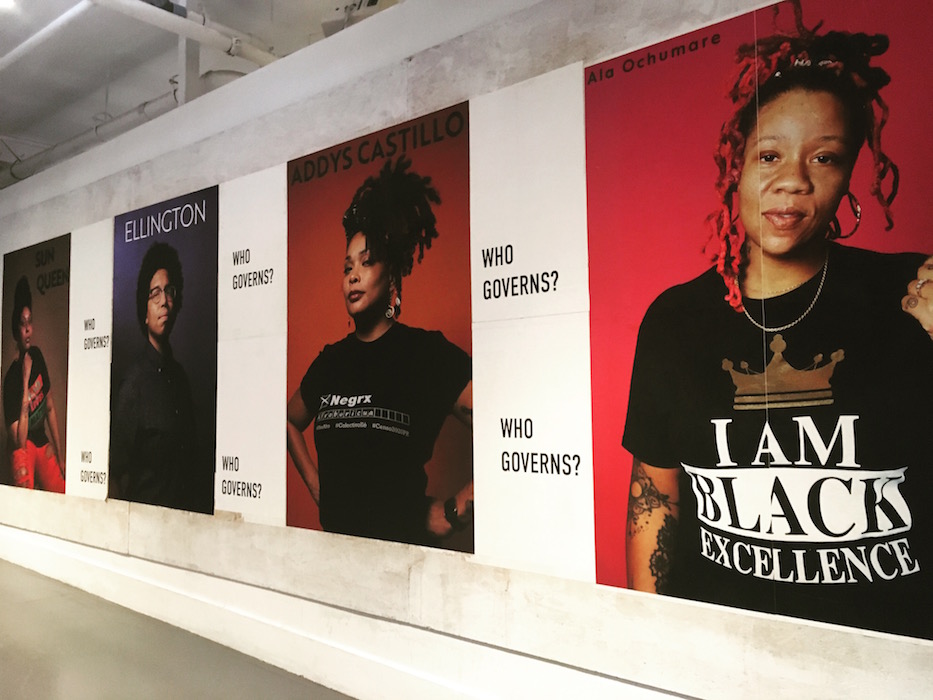
Arts & Culture | Artspace New Haven | Ninth Square | Visual Arts | COVID-19

A detail from Bek Andersen's Power Portraits picturing Sun Queen, Kerry Ellington, Addys Maria Castillo and Ala Ochumare. Lucy Gellman Photos; all artwork is by the artists in the show.
Ala Ochumare stares into the camera, a smile teasing at the edges of her mouth. Her right hand grazes her shoulder as it rises in a fist. Her head tilts to one side, exposing a glinting gold hoop. A three-pronged crown beckons from her shirt, guiding viewers to the message beneath it. I AM BLACK EXCELLENCE, it reads.
Bek Andersen’s Power Portraits are part of Who Governs?, a sweeping look at recent New Haven history running at Artspace New Haven now through Dec. 12. A celebration of Robert Dahl’s 1961 book of the same name, the show is curated by Frank Mitchell, director emeritus of the Amistad Center for Art & Culture in Hartford and a longtime advocate of the arts in New Haven. It features artists Bek Andersen, Emily Larned, Bev Richey, and Bayeté Ross Smith.
The show yokes past and present from its outset, as Mitchell puts Dahl’s work into context. In 1961, Dahl published the first edition of Who Governs?: Democracy and Power in an American City during his tenure as a professor of political science at Yale University. In the book, Dahl uses the city of New Haven as a case study, exploring its people and its municipal government to argue for a pluralistic tilt to city politics. The argument, which Mitchell calls radical for its time, went against the suggestion that power, like wealth, rested in the hands of the few.
The book came as Dahl—and Americans—were experiencing a greater political shift in the country towards civil rights, women’s rights, increased access to civic institutions and the pushback that inevitably followed all of those. In 1960, John F. Kennedy defeated Richard Nixon, who had served for eight years as vice president to Dwight D. Eisenhower. In the city, Mayor Dick Lee was well on his way to being the architect of urban renewal, the scars of which are still very much alive and visible today.
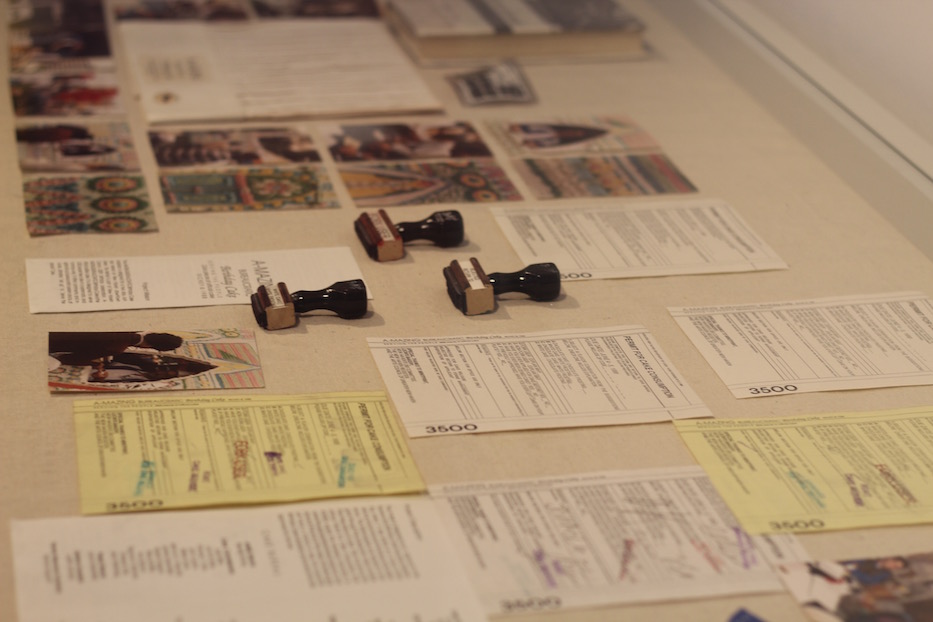
Detail, Bev Richey's installation for The A-Mazing Bureaucratic Birthday Cake.
Blessedly, Who Governs? is not a show about the book but about its cultural and civic aftershocks and implications. In a mostly-empty side gallery that looks out onto Orange Street, Mitchell has installed large vinyl labels with quotes from Mierle Laderman Ukeles and Félix González-Torres, both of whom changed the landscape of public art in the second half of the twentieth century. It gives the viewer a sort of pretext: that this show is both hyper-local and a product of larger shifts in American art and politics.
Artists frame history as a living thing, and the show is better for it. Across from Mitchell’s introductory text, Richey has created an archive around The A-Mazing Bureaucratic Birthday Cake, a June 1988 art installation designed and consumed for the city’s 350th birthday celebrations on the New Haven Green. At the time, Richey was a member of the then-fledgling Arts Council of Greater New Haven and a working artist herself. Biagio DiLieto was serving what would be his last term as mayor. Festival coordinator and artist Robert Gregson commissioned Richey for the piece.
To complete the project, she worked with a team of 50 artists-turned-“cake commissioners,” as well as members of the Arts Council of Greater New Haven, the New Haven Register, and Leon Weinberg of the now-defunct Leon’s Bakery to build a large, scalable iced replica of City Hall and provide enough sheet cake to feed 3,500 city residents. True to the installation’s name—and its attempt to mirror city policy—residents had to make it through a maze to receive a piece of cake, for which they received a permit for consumption. Even the building and its iced replica resonated: Henry Austin built New Haven’s gingerbread house of a City Hall in 1861, exactly 100 years before Who Governs? was published and 127 years before the city's birthday.
Amidst parades, horse-drawn carriage rides, live music and dancing on the Green in 1988, cake commissioners and celebrity guests doled out sweet slices with permits to consume cake. They used rubber stamps for fork usage and appropriate cake zoning. Richey’s aim was not just celebratory: she also intended to remind DiLieto and the city’s Board of Alders (then dubbed the Board of Aldermen) that there was an acute need for affordable artists' housing across the city. It’s a need that still exists—and is perhaps exacerbated by New Haven’s number of luxury apartments—today.
In the gallery, Richey has assembled a small display that walks viewers through the installation, with photographs, preserved rubber stamps, old programs and a screen-printed shirt from the event. It’s a window into history that is both cheeky and instructive: the things Richey was asking for in 1988 are still things artists are asking for today. The only difference is that New Haven is 32 years and four mayoral administrations older than it was then.
When a viewer sees a faded yellow “permit to eat cake,” they may be reminded of the long, confusion-riddled showdown between artists and alders over who got to live in the Hamilton Street Clock Factory last year. Or, perhaps, the narrow-eyed befuddlement that often strikes first-time presenters to the city’s Historic District Commission, when a ten-minute request is met with four hours of debate. Or the Board of Alders' struggle to balance the city budget each year when 60 percent of the city’s grand list is tax exempt.
"The bureaucracy involved frightens, inspires and fascinates me," Richey told the New Haven Register in June 1988. "But through it all I've discovered that systems, hierarchy, aren't necessarily bad, that in certain cases they are essential to get things done. It's been quite a stretch for me working with so many individuals and groups."
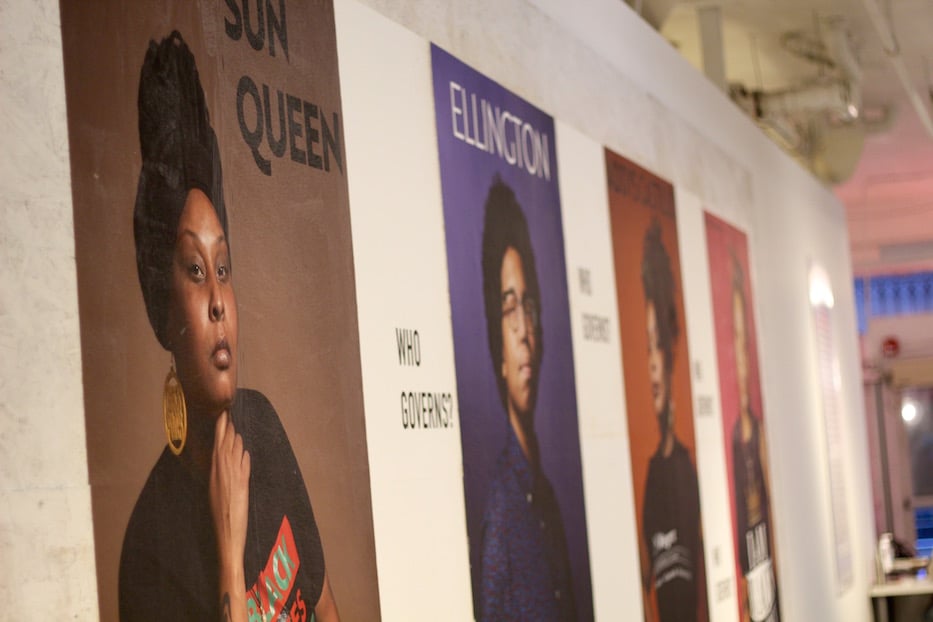
Detail, Bek Andersen's Power Portraits.
As a bridge from past to present, Bek Andersen’s Power Portraits bring a viewer right into 2020. The artist has laid her process bare: an in-house studio in the next gallery is plastered with the bubblegum- and neon-colored backgrounds against which she photographs. The gallery pulses with the process of reclamation: a queer artist picturing Black and Brown subjects, mostly queer women, in a medium that has long been categorized as overwhelmingly white, cisgender and male.
On one wall, viewers come face-to-face with the organizers Sun Queen, Kerry Ellington, Addys Castillo, and Ala Ochumare, who have been at the forefront of Black Lives Matter New Haven, People Against Police Brutality, and Citywide Youth Coalition for years. Near the gallery’s Crown Street widows, a viewer spots Black Lives Matter New Haven organizers Ashleigh Huckabey, Sy Frasier, and MiAsia Harris, Pastor Kelcy Steele, and mentor Tyrone Jones.
Andersen’s focus, rendered in saturated color, gives viewers a chance to pause with these dynamos, whose concern for the community has often come at the expense of their own self care. They are pictured in a tradition that lives between sainthood and superhero, endowed with the power of making the city a better version of itself. And they are: all of them have been pushing for systemic, legislative change in the city for years. Not just at the front of protests this year, but in community backpack drives, public art projects, youth-led calls to get cops out of schools, and public testimonies for greater police accountability.
Andersen holds a delicate balance in her hands: the portraits feel intimate yet public; majestic but down to earth. At the far left, Sun Queen lifts her right hand over a shirt that reads “Black Lives Matter,” resting it gingerly beneath her chin. Her eyes lock with a viewer’s, eyebrows raised in a question. Her skin glows, light spilling over her face and arms. There’s nothing pushy or pugnacious here: her authority, like her name, is her birthright. So too for Ellington and Castillo, who look out as if they are standing over the city—their city—and can see with crystal clarity the next steps New Haven needs to take.

The photographs live alongside Smith’s multimedia installation Got The Power, as if to layer reclamation on reclamation. Sound bounces across the gallery, a speaker positioned to seem like it is emanating from a bright boombox made of sugarcane and cotton pulp.
Deftly, the artist threads music, appropriation, anti-Black policing and economic deprivation, and the iconic imagery of the boombox itself. It feels like the accompaniment to NPR’s Louder Than A Riot that listeners didn’t know they needed. The installation is a collaboration with the manufacturer PulpWorks and asks New Haveners to submit their audio recordings for an accompanying mixtape.
“Sweet is the only way to describe the serendipity of recycling two commodities—sugar and cotton—associated with Black bodies in antebellum America to produce the shell of an object associated with hip-hop culture,” reads an accompanying label. “This piece continues a tradition of flagging the contradictions of citizenship from the 1920 NAACP anti-lynching banner, to interpretations on the national flag by Dana Chandler, Faith Ringgold, and David Hammons.”
The works weave an asynchronous narrative right into Larned’s 2020 Police Others As You Would Have Others Police You, a sweeping installation that takes on the history and legacy of community policing under Chief Nicholas Pastore and educator K.D. Codish. Codish was recruited in March 1992 to lead training and education at the New Haven Police Academy.
Her background wasn’t in law enforcement. Prior to her time at the academy, Codish led a feminist theater company called Theatre of Light and Shadow, founded and led the city’s first Take Back The Night marches against sexual assault and rape, and served as an educator at both the Yale School of Medicine and AIDS Project New Haven (now A Place to Nourish Your Health). She wrote articles about domestic abuse and called for HIV education campaigns that targeted all city residents in English and Spanish.
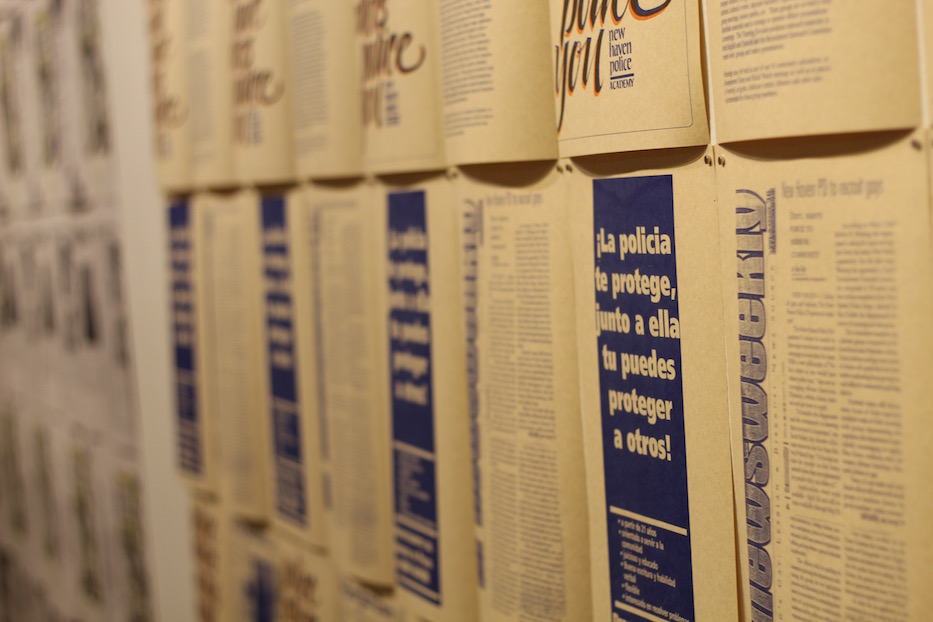
Detail, Police Others As You Would Have Others Police You.
At the time that Codish was hired, Pastore recognized “not only that the situation was bad, but that police were part of the problem,” she wrote in a 1996 report titled “The New Haven Police Academy: Putting A Sacred Cow Out To Pasture.” “He maintained that what the police were doing and how they were doing it were clearly not working, and that the ‘new’ community policing philosophy (not yet considered a strategy) was a viable alternative.”
Her approach, chronicled in a series of archival news clippings and advertisements from the time, was to reform the academy both internally and externally. At the same time that Rafael Ramos was starting Bregamos Community Theater as an de-institutionalized outlet for public health, she took that approach to the academy. She grew collaborative community-wide initiatives focusing on empathy and listening. She built teen theater troupes that wrote and performed alongside police recruits.
That approach springs back to life as the artist layers and repeats archival images, such that they become a sort of technicolor, weathered mantra. Larned does not romanticize 1990s New Haven: Codish took over the academy at the height of the HIV/AIDS epidemic in New Haven, when the city was also reeling from crack, citywide violence, and a rate of infant mortality among Black babies that was far higher than that of their white counterparts in the city and the country. She was fighting a battle in a city that was a different place than it is today.
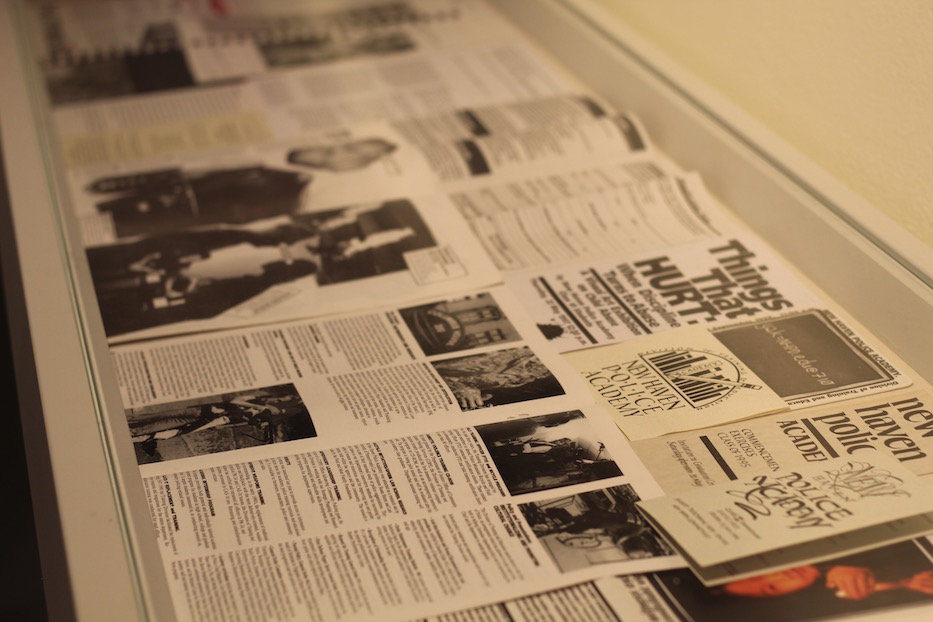
Detail, Police Others As You Would Have Others Police You.
But Larned also celebrates Codish’s approach, punctuated by a kind of moxie that now feels foreign to Otoniel Reyes' tenure as chief. Across the walls and several display cases, Larned tells the story of how Codish transformed the department, from raising recruits’ exam scores to weaving role-playing and dramatic arts into community-cop relations. Viewers are invited to watch archival academy training videos on an old television that sits in the corner of the gallery.
In her work, Larned explains, Codish influenced a generation of officers who have since retired or moved on, from Holly Wasilewski to former Chief Anthony Campell. In 2008, she was one of 34 people that the city laid off as it scrambled to close a $6 million gap in the city budget.
In laying out the installation, Larned pushes her viewer to interrogate what they understand of the department—past, present, and future—versus its multiple realities, missteps, and regressions. In a year that has included the use of force on protesters from police in riot gear, it makes a viewer think twice about a department that now seems more about policing the community than community policing. Without ever having to use the words, it also asks how New Haven can get back to a community-centered model, from city negotiations with the local police union to crisis response alternatives to law enforcement.
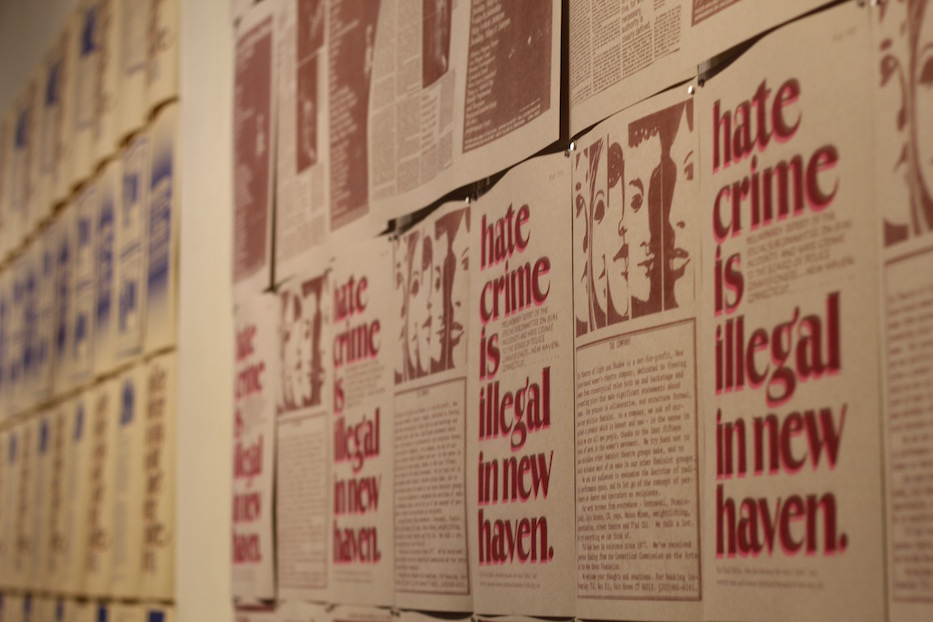
Detail, Police Others As You Would Have Others Police You.
As it comes full circle, the exhibition seems aligned with both Who Governs? and Dahl’s 1989 Democracy and Its Critics, which dove further into the question of civic participation. Indeed, the show challenges a viewer to question the narrative of forward progress that both the city’s Economic Development Administration and Yale University have pushed aggressively for the last several decades, as luxury apartments and big-box retail stores have replaced independent businesses and affordable housing has become increasingly elusive.
Artists are not just asking “who governs,” but also “by what means?” Is it through sustained collective action, or a sheet cake that doubles as an argument for affordable housing? Is it done with the city’s blessing, or in opposition to it? If the system is broken, do the people need to ask for its permission in the first place?
Maybe, artists submit, it’s a hybrid of the two. Sometimes the past repeats itself, like a record hitching on loop after too many plays. Sometimes it’s buried, until an artist unearths it and literally plasters it across the walls. Sometimes the cycle breaks, and change marches methodically forward.
What is up to viewers, at the end of the show, is what future they want to be a part of.
Who Governs? runs at Artspace New Haven through Dec. 12. Artspace is open Wednesday through Saturday, 12 p.m. to 6 p.m. Attendees are required to wear masks at all times. A panel A Zoom reunion of commissioners from the A-Mazing Beaurocratic Birthday Cake is scheduled for Nov. 18 at 7 p.m.

